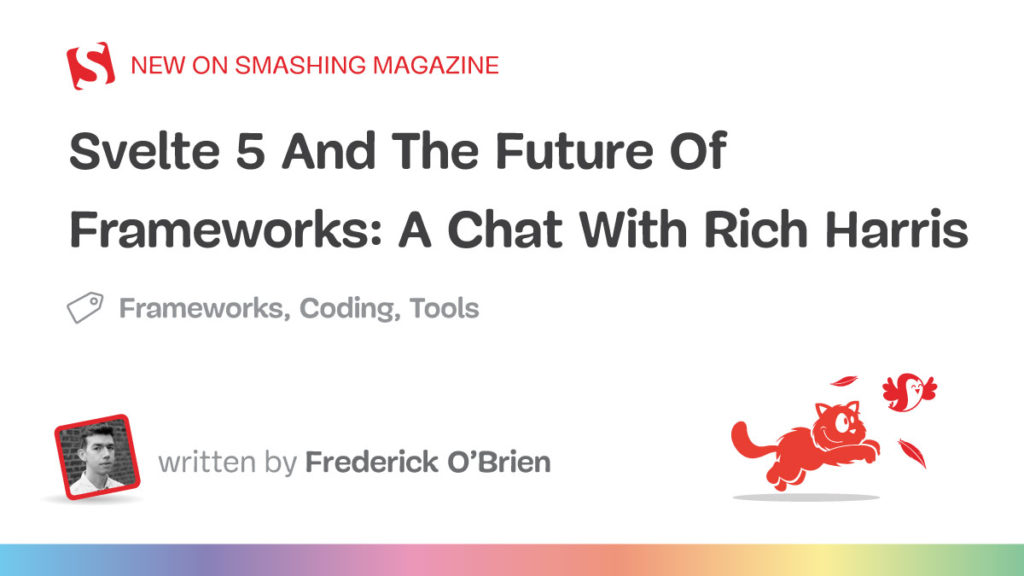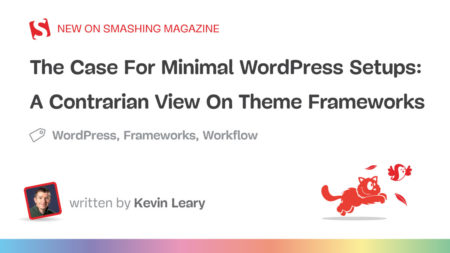Svelte occupies a curious space within the web development world. It’s been around in one form or another for eight years now, and despite being used by the likes of Apple, Spotify, IKEA, and the New York Times, it still feels like something of an upstart, maybe even a black sheep. As creator Rich Harris recently put it,
“If React is Taylor Swift, we’re more of a Phoebe Bridges. She’s critically acclaimed, and you’ve heard of her, but you probably can’t name that many of her songs.”
— Rich Harris
This may be why the release of Svelte 5 in October this year felt like such a big deal. It tries to square the circle of convention and innovation. Can it remain one of the best-loved frameworks on the web while shaking off suspicions that it can’t quite rub shoulders with React, Vue, and others when it comes to scalability? Whisper it, but they might just have pulled it off. The post-launch reaction has been largely glowing, with weekly npm downloads doubling compared to six months ago.
Still, I’m not in the predictions game. The coming months and years will be the ultimate measure of Svelte 5. And why speculate on the most pressing questions when I can just ask Rich Harris myself? He kindly took some time to chat with me about Svelte and the future of web development.
Not Magic, But Magical
Svelte 5 is a ground-up rewrite. I don’t want to get into the weeds here — key changes are covered nicely in the migration guide — but suffice it to say the big one where day-to-day users are concerned is runes. At times, magic feeling $ has given way to the more explicit $state, $derived, and $effect.
A lot of the talk around Svelte 5 included the sentiment that it marks the ‘maturation’ of the framework. To Harris and the Svelte team, it feels like a culmination, with lessons learned combined with aspirations to form something fresh yet familiar.
“This does sort of feel like a new chapter. I’m trying to build something that you don’t feel like you need to get a degree in it before you can be productive in it. And that seems to have been carried through with Svelte 5.”
— Rich Harris
Although raw usage numbers aren’t everything, seeing the uptick in installations has been a welcome signal for Harris and the Svelte team.
“For us, success is definitely not based around adoption, though seeing the number go up and to the right gives us reassurance that we’re doing the right thing and we’re on the right track. Even if it’s not the goal, it is a useful indication. But success is really people building their apps with this framework and building higher quality, more resilient, more accessible apps.”
— Rich Harris
The tenets of a Svelte philosophy outlined by Harris earlier this year reinforce the point:
- The web matters.
- Optimise for vibes.
- Don’t optimise for adoption.
- HTML, The Mother Language.
- Embrace progress.
- Numbers lie.
- Magical, not magic.
- Dream big.
- No one cares.
- Design by consensus.
Click the link above to hear these expounded upon, but you get the crux. Svelte is very much a qualitative project. Although Svelte performs well in a fair few performance metrics itself, Harris has long been a critic of metrics like Lighthouse being treated as ends in themselves. Fastest doesn’t necessarily mean best. At the end of the day, we are all in the business of making quality websites.
Frameworks are a means to that end, and Harris sees plenty of work to be done there.
Software Is Broken
Every milestone is a cause for celebration. It’s also a natural pause in which to ask, “Now what?” For the Svelte team, the sights seem firmly set on shoring up the quality of the web.
“A conclusion that we reached over the course of a recent discussion is that most software in the world is kind of terrible. Things are not good. Half the stuff on my phone just doesn’t work. It fails at basic tasks. And the same is true for a lot of websites. The number of times I’ve had to open DevTools to remove the disabled attribute from a button so that I can submit a form, or been unclear on whether a payment went through or not.”
— Rich Harris
This certainly meshes with my experience and, doubtless, countless others. Between enshittification, manipulative algorithms, and the seemingly endless influx of AI-generated slop, it’s hard to shake the feeling that the web is becoming increasingly decadent and depraved.
“So many pieces of software that we use are just terrible. They’re just bad software. And it’s not because software engineers are idiots. Our main priority as toolmakers should be to enable people to build software that isn’t broken. As a baseline, people should be able to build software that works.”
— Rich Harris
This sense of responsibility for the creation and maintenance of good software speaks to the Svelte team’s holistic outlook and also looks to influence priorities going forward.
Brave New World
Part of Svelte 5 feels like a new chapter in the sense of fresh foundations. Anyone who’s worked in software development or web design will tell you how much of a headache ground-up rewrites are. Rebuilding the foundations is something to celebrate when you pull it off, but it also begs the question: What are the foundations for?
Harris has his eyes on the wider ecosystem around frameworks.
“I don’t think there’s a lot more to do to solve the problem of taking some changing application state and turning it into DOM, but I think there’s a huge amount to be done around the ancillary problems. How do we load the data that we put in those components? Where does that data live? How do we deploy our applications?”
— Rich Harris
In the short to medium term, this will likely translate into some love for SvelteKit, the web application framework built around Svelte. The framework might start having opinions about authentication and databases, an official component library perhaps, and dev tools in the spirit of the Astro dev toolbar. And all these could be precursors to even bigger explorations.
“I want there to be a Rails or a Laravel for JavaScript. In fact, I want there to be multiple such things. And I think that at least part of Svelte’s long-term goal is to be part of that. There are too many things that you need to learn in order to build a full stack application today using JavaScript.”
— Rich Harris
- Why Don’t We Have A Laravel For JavaScript? by Theo Browne
- “Why We Don’t Have a Laravel For JavaScript… Yet” by Vince Canger
Onward
Although Svelte has been ticking along happily for years, the release of version 5 has felt like a new lease of life for the ecosystem around it. Every day brings new and exciting projects to the front page of the /r/sveltejs subreddit, while this year’s Advent of Svelte has kept up a sense of momentum following the stable release.
Below are just a handful of the Svelte-based projects that have caught my eye:
- webvm: Virtual Machine for the Web
- number-flow: An animated number component for React, Vue, and Svelte
- sveltednd: A lightweight, flexible drag and drop library for Svelte 5 applications
- Threlte 8
Despite the turbulence and inescapable sense of existential dread surrounding much tech, this feels like an exciting time for web development. The conditions are ripe for lovely new things to emerge.
And as for Svelte 5 itself, what does Rich Harris say to those who might be on the fence?
“I would say you have nothing to lose but an afternoon if you try it. We have a tutorial that will take you from knowing nothing about Svelte or even existing frameworks. You can go from that to being able to build applications using Svelte in three or four hours. If you just want to learn Svelte basics, then that’s an hour. Try it.”
— Rich Harris
Further Reading On SmashingMag
- “How To Build Server-Side Rendered (SSR) Svelte Apps With SvelteKit,” Sriram Thiagarajan
- “Web Development Is Getting Too Complex, And It May Be Our Fault,” Juan Diego Rodríguez
- “Vanilla JavaScript, Libraries, And The Quest For Stateful DOM Rendering,” Frederik Dohr
- “The Hype Around Signals,” Atila Fassina
Source: Read MoreÂ




